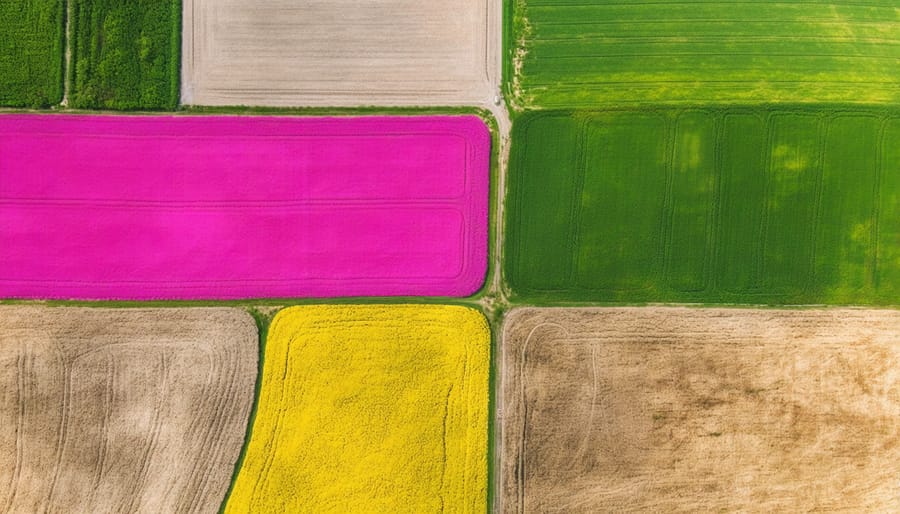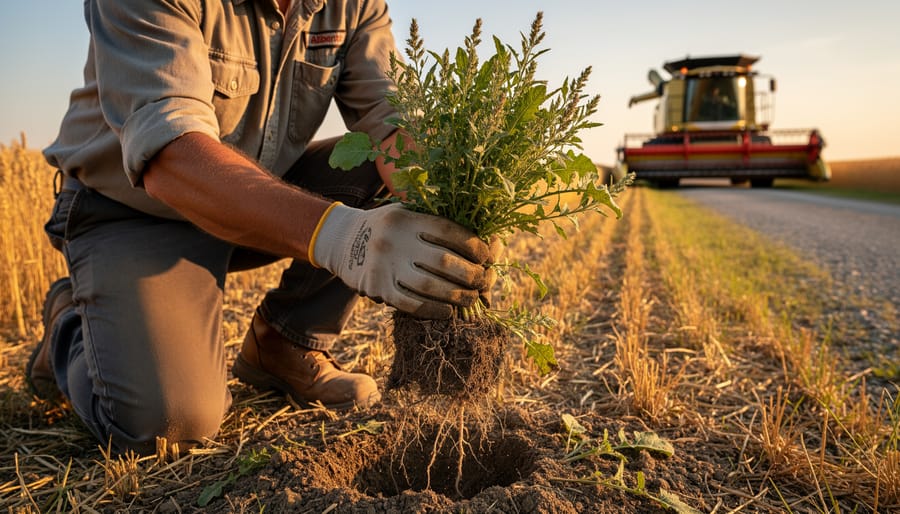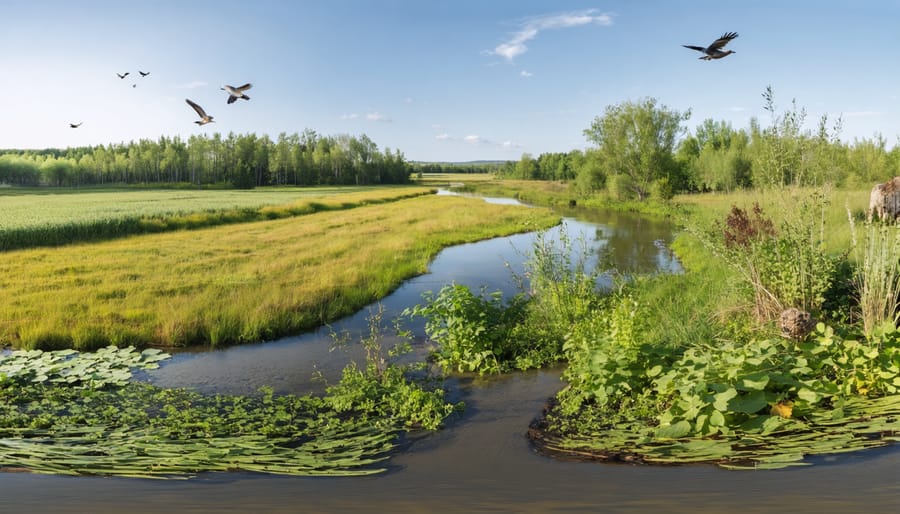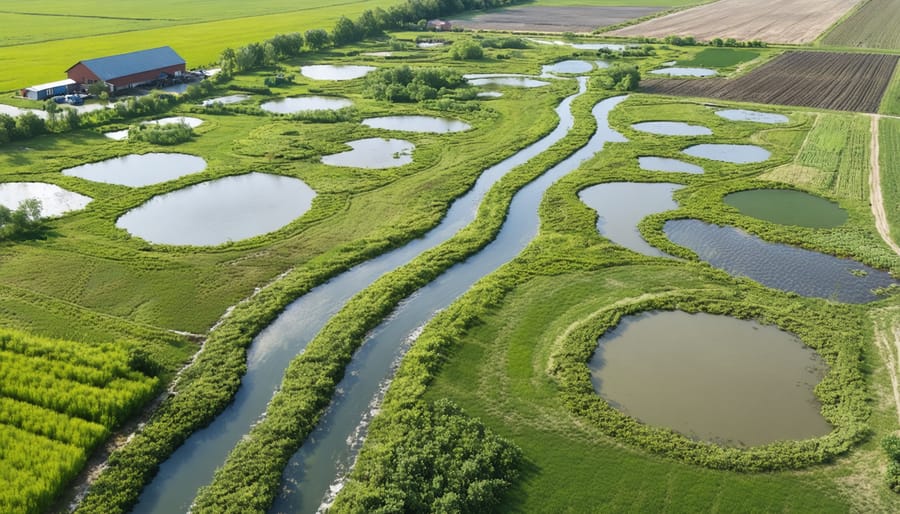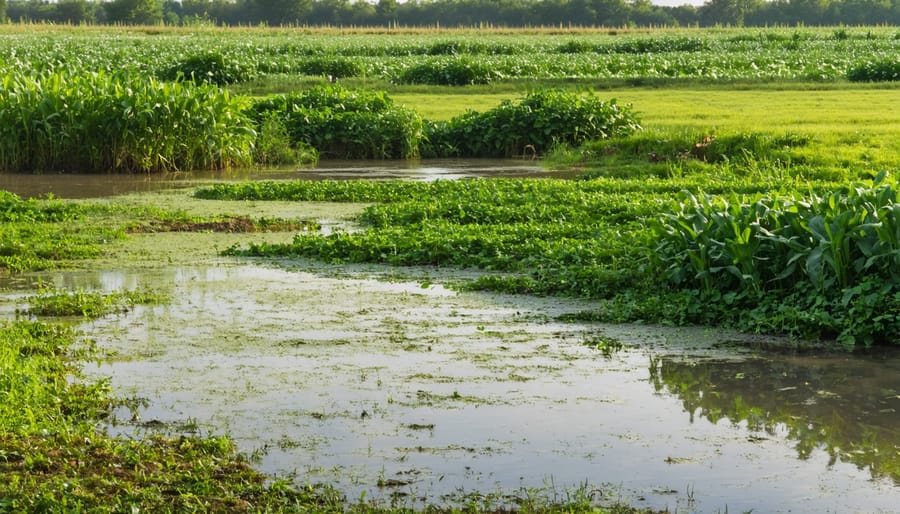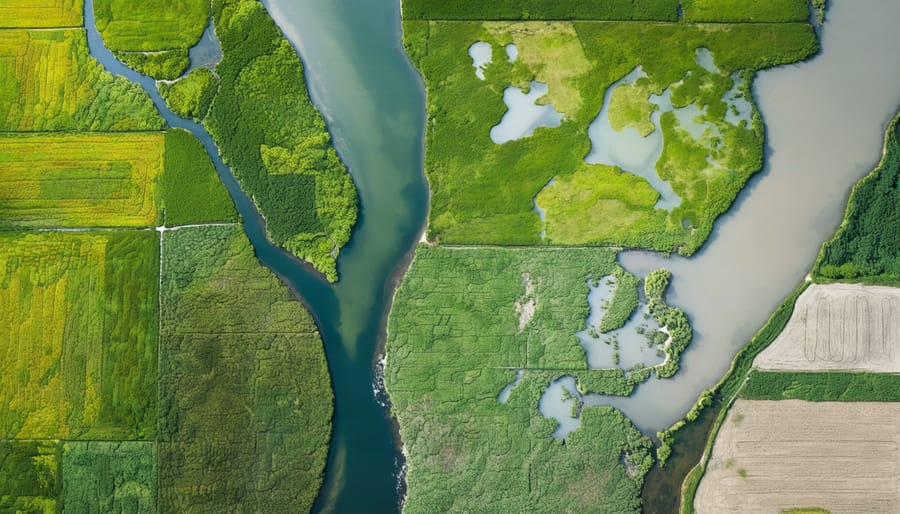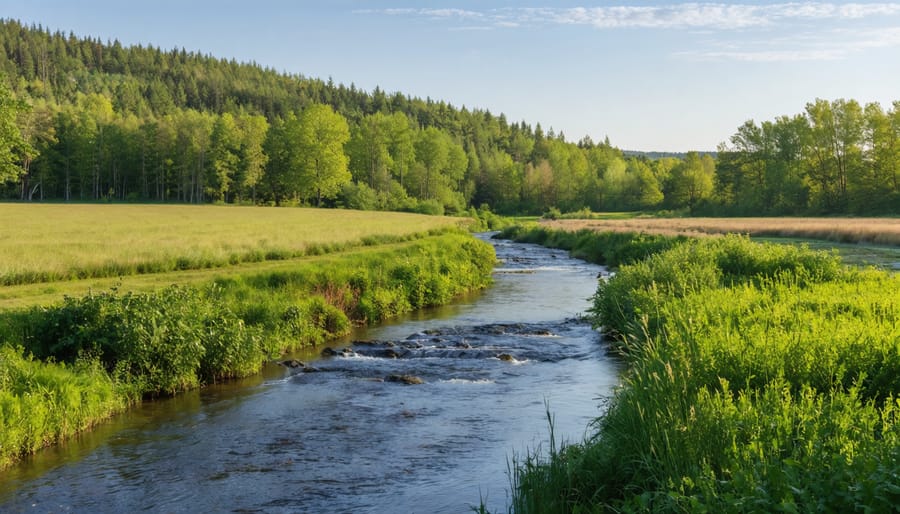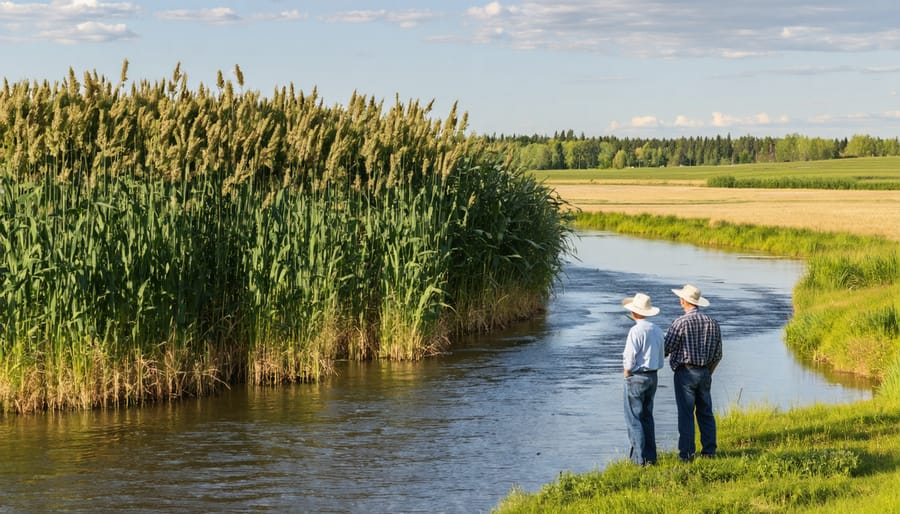Across Alberta’s farmlands, the connection between biodiversity and climate resilience has never been more crucial. As temperatures shift and weather patterns become increasingly unpredictable, our agricultural communities are discovering that diverse ecosystems offer practical solutions for both adaptation and profitability.
Local farmers like Jim Thompson of Lethbridge County have already witnessed how increasing plant diversity in their operations helps buffer against extreme weather events. By incorporating native grassland species alongside traditional crops, Thompson’s farm maintained productivity during the 2021 drought while neighboring monoculture operations struggled.
The science is clear: farms with greater biodiversity are 30% more resilient to climate fluctuations than those with limited species variety. For Alberta producers, this translates to tangible benefits – from improved soil moisture retention to natural pest control, all while creating new revenue streams through carbon credits and ecosystem services.
This growing movement toward biodiversity isn’t just about environmental stewardship – it’s about building stronger, more profitable farms that can weather whatever challenges climate change brings. Through practical strategies and proven techniques developed right here in our province, Alberta farmers are leading the way in showing how biodiversity and agricultural success go hand in hand.
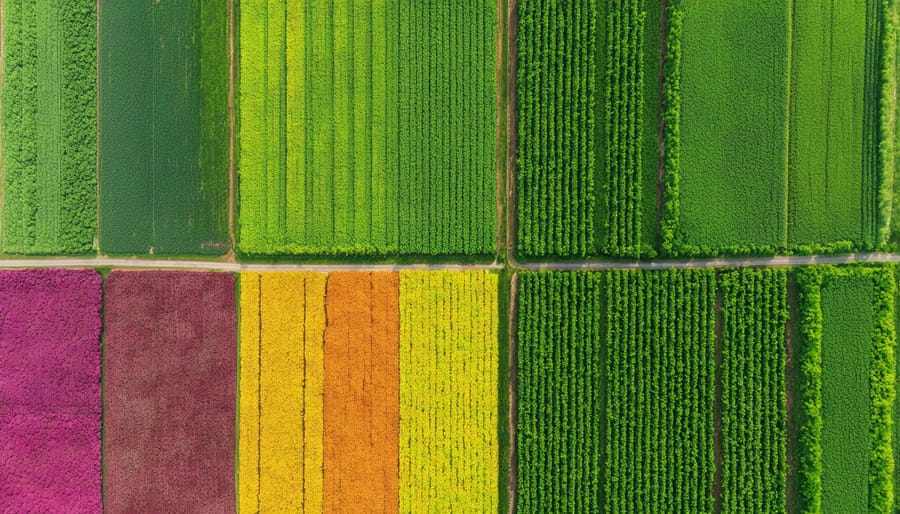
The Power of Agricultural Biodiversity in Climate Resilience
Temperature and Drought Resistance
Diverse crop varieties act as a natural insurance policy against extreme weather conditions, particularly important for Alberta’s varying climate. When farmers plant different varieties of the same crop, they create a buffer against temperature fluctuations and drought stress. For example, some wheat varieties might thrive in hot, dry conditions while others perform better in cooler, wetter weather.
Local farmer Mike Thompson from Lethbridge shares his experience: “By planting three different wheat varieties across my fields, I’ve managed to maintain stable yields even during unpredictable seasons. When one variety struggles, another often compensates.”
Research from the University of Alberta demonstrates that farms with higher crop diversity are 30% more likely to maintain consistent yields during extreme weather events. Native crop varieties, particularly those adapted to Prairie conditions, often show remarkable resilience to both heat and water stress.
For best results, consider incorporating drought-resistant heritage varieties alongside modern cultivars. This strategy not only protects against climate uncertainties but also helps preserve valuable genetic diversity for future generations of Canadian farmers.

Natural Pest Management Benefits
In Alberta’s agricultural landscape, fostering biodiversity offers a powerful natural defense against pest problems. When we maintain diverse plant species and beneficial insects on our farms, we create a balanced ecosystem that naturally regulates pest populations. For example, many Alberta farmers have reported significant reductions in canola flea beetle damage after establishing flowering field margins that attract beneficial predatory insects.
Local studies show that farms with greater biodiversity typically use 30-50% less pesticides than conventional monoculture operations. This not only cuts down on input costs but also helps preserve beneficial soil organisms that enhance crop resilience to climate stress. Prairie farmers who integrate native flowering plants and maintain natural hedgerows often see increased populations of pollinators and natural pest predators like ladybugs and parasitic wasps.
The economic benefits are substantial – reduced pesticide costs, better crop quality, and improved soil health all contribute to a more resilient farm operation. Plus, maintaining diverse ecosystems helps buffer against the increasing pest pressures we’re seeing with climate change, as different species can step in when others are stressed by extreme weather conditions.
Success Stories: Alberta’s Biodiversity Champions
Mixed Farming Success in Southern Alberta
The Davidson family farm in Coaldale has become a shining example of successful mixed farming adaptation in Southern Alberta. Over the past decade, they’ve transformed their 800-hectare operation into a diverse agricultural ecosystem that’s both profitable and resilient to climate change.
By integrating cattle grazing with crop rotation, the Davidsons have increased their soil organic matter by 2.5% while reducing synthetic fertilizer use by 40%. Their carefully planned rotation includes traditional wheat and canola alongside drought-resistant legumes like faba beans and field peas, which help fix nitrogen in the soil.
“The cattle do the work for us,” explains Sarah Davidson. “They graze crop residues in winter, naturally fertilizing the fields and reducing our equipment costs.” This integration has helped the farm maintain productivity even during recent drought years, when many conventional operations struggled.
The family’s approach includes maintaining natural wetlands and implementing shelter belts, which provide habitat for beneficial insects and birds. These features have reduced pest problems and improved pollination rates in their canola fields.
Their success hasn’t gone unnoticed. Local agricultural extension services now use the Davidson farm as a demonstration site for climate-smart farming practices. The operation has documented a 30% increase in overall farm revenue since implementing these changes, proving that biodiversity and profitability can go hand in hand in the Canadian prairies.
Indigenous Farming Wisdom in Practice
Indigenous communities across Canada have long practiced sophisticated farming methods that inherently support biodiversity while building climate resilience. Today’s farmers are increasingly recognizing the value of this traditional farming knowledge in developing sustainable agricultural practices.
In Alberta, farmers are successfully implementing Indigenous companion planting techniques, such as the Three Sisters method – growing corn, beans, and squash together. This approach naturally enhances soil fertility, reduces water usage, and creates beneficial insect habitats. Local farmers report up to 20% higher yields using these integrated growing systems compared to monoculture practices.
Indigenous wisdom also emphasizes the importance of working with natural water cycles. Several Alberta farms have adopted traditional water management techniques, including strategic placement of windbreaks and natural swales, which help retain moisture during dry periods while protecting against erosion during heavy rainfall events.
Another valuable practice is the Indigenous approach to seed saving and selective breeding for local conditions. Many Alberta farmers now maintain seed libraries featuring varieties specifically adapted to our region’s unique climate challenges. This practice helps preserve genetic diversity while ensuring crop resilience to changing weather patterns.
These time-tested methods demonstrate how incorporating Indigenous agricultural practices can enhance farm productivity while building climate change resilience in modern farming operations.
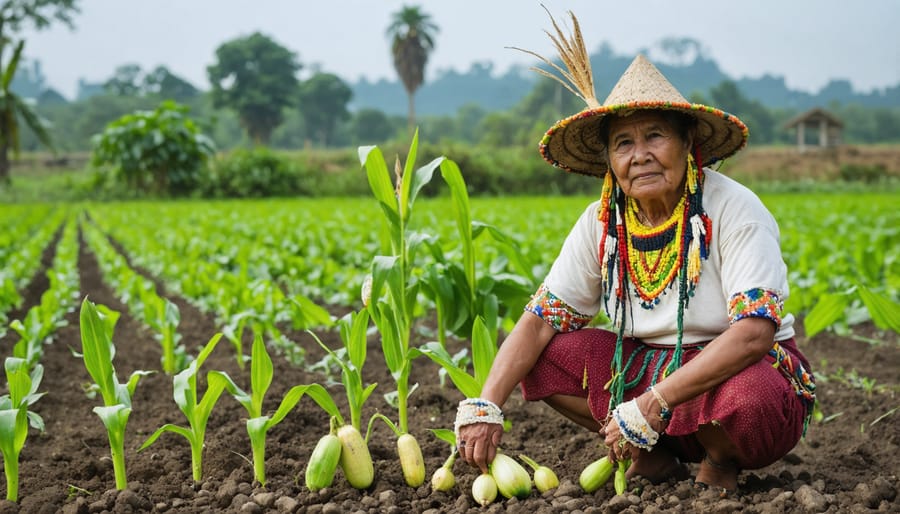
Practical Steps to Enhance Farm Biodiversity
Crop Rotation and Intercropping
In Alberta’s varied climate zones, implementing effective crop rotation and intercropping strategies has become increasingly important for maintaining soil health and building resilience against extreme weather events. By diversifying your cropping system, you’re not only protecting against crop failure but also creating robust ecosystems that support beneficial insects and soil microorganisms.
A successful three to four-year rotation typically includes alternating between cereals, legumes, and oilseeds. For example, many Alberta farmers have found success with a wheat-canola-peas rotation, while others incorporate barley or oats as additional options. This diversity helps break pest and disease cycles while improving soil structure and nutrient availability.
Intercropping, the practice of growing two or more crops simultaneously in the same field, has shown promising results across the prairies. Popular combinations include peas with canola, or lentils with flax. Dave Thompson, a farmer near Red Deer, reports a 15% increase in total yield and improved soil moisture retention since implementing these practices three years ago.
Consider these practical steps for implementation:
– Start small with test plots to evaluate which combinations work best for your land
– Monitor soil moisture levels and adjust planting dates accordingly
– Use precision farming equipment to manage different crop requirements efficiently
– Document your results to fine-tune the system over time
Remember that timing is crucial in our short growing season. Plant your intercrops when soil temperatures reach at least 5°C, typically in early May for most regions. Many local agricultural extension offices offer support in planning your rotation and can connect you with experienced farmers in your area who’ve successfully adopted these practices.
Heritage Seed Integration
Heritage seeds carry the wisdom of generations of farmers who selected crops specifically adapted to local conditions. For Alberta farmers looking to enhance their operation’s resilience, incorporating these traditional varieties alongside modern crops creates a robust foundation for climate adaptation.
Start by identifying heritage varieties that historically thrived in your region. The University of Alberta’s seed library and local seed-saving networks are excellent resources for sourcing these traditional crops. Many Alberta farmers have found success with Red Fife wheat, which demonstrates excellent drought tolerance, and heritage varieties of barley that show strong disease resistance.
Begin integration on a small scale, dedicating 1-2 hectares to heritage varieties. This allows you to observe their performance while minimizing risk. Consider establishing test plots where you can compare different varieties under identical conditions. Many successful Alberta farmers use a companion planting approach, growing heritage varieties alongside modern cultivars to maximize learning opportunities.
Local farmer Mary Thompson from Olds reports: “We started with just half a hectare of heritage wheat three years ago. Now we’re growing 20 hectares of diverse heritage grains, and they’ve helped us weather unpredictable conditions better than ever.”
To ensure success, document your observations carefully. Track factors like germination rates, drought tolerance, and yield under various weather conditions. Connect with other farmers in your area who are working with heritage varieties – their experience can provide valuable insights for your operation.
Remember that heritage seed integration isn’t about replacing your entire crop system, but rather about building diversity and resilience. Start small, learn from experience, and gradually expand what works for your specific situation.
Economic Benefits of Biodiversity
The economic benefits of biodiversity extend far beyond environmental protection, offering tangible financial advantages for Alberta farmers. Research conducted by the University of Alberta shows that farms maintaining diverse crop rotations typically see a 15-20% increase in overall profitability compared to monoculture operations.
Consider the case of Sarah Thompson, a third-generation farmer near Lethbridge, who introduced five new crop varieties to her rotation over three years. Her farm’s net income increased by 23% through reduced pesticide costs and improved soil health. By incorporating companion planting and beneficial insects, she cut her pest management expenses by nearly $75 per hectare.
Biodiversity also serves as a natural insurance policy against climate-related challenges. When one crop struggles due to adverse weather conditions, others may thrive, helping maintain stable farm income. For instance, farms in the Peace River region practicing intercropping reported 30% less crop loss during the 2021 drought compared to conventional operations.
Market opportunities expand with increased biodiversity as well. Heritage grain varieties and unique crop combinations can command premium prices in specialty markets. Local success stories include the Red Deer Valley Regenerative Farmers’ Cooperative, whose members earn an average of 40% more per hectare by selling diverse, climate-resilient crops to specialty buyers.
Additionally, maintaining healthy soil through biodiversity reduces input costs. Alberta farmers practicing diverse rotation systems report spending approximately $200 less per hectare on synthetic fertilizers annually. The presence of various beneficial insects and microorganisms naturally enhances soil fertility and pest resistance, creating a self-sustaining ecosystem that requires fewer expensive interventions.
These economic advantages become particularly significant as climate patterns become more unpredictable. By investing in biodiversity now, farmers can build resilient operations that remain profitable despite changing conditions while contributing to long-term environmental sustainability.
As Alberta’s farming community faces the challenges of climate change, protecting and enhancing biodiversity on our farms isn’t just an environmental choice – it’s a smart business decision. The evidence is clear: farms that incorporate diverse species, maintain healthy soil ecosystems, and protect natural habitats are more resilient to extreme weather events and changing climate patterns.
By implementing the strategies we’ve discussed, from establishing pollinator corridors to practicing crop rotation and maintaining wetlands, you’re not only supporting local wildlife but also strengthening your farm’s ability to adapt and thrive. Remember, every hectare of diverse habitat on your land acts as a natural insurance policy against climate uncertainty.
Your efforts matter. Whether you’re starting with a small shelter belt or transforming entire fields into diverse agricultural ecosystems, you’re contributing to both environmental sustainability and agricultural resilience. Connect with local agricultural extension services, join farmer-led initiatives, and share your experiences with neighbors. Together, we can build a future where Canadian farms lead the way in biodiversity-smart agriculture.
The time to act is now. Let’s work together to create farming systems that are good for our land, good for our bottom line, and good for generations to come.

